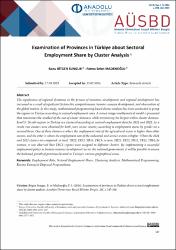Examination of Provinces in Türkiye about Sectoral Employment Share by Cluster Analysis
Abstract
The significance of regional dynamics in the process of economic development and regional development has increased as a result of significant factors like competitiveness, human resource development, and observation of the global market. In this study, mathematical programming-based cluster analysis has been conducted to group the regions in Türkiye according to sectoral employment rates. A mixed integer mathematical model is presented that maximizes the smallest of the out-of-cluster distances while minimizing the largest within-cluster distance. Level 2- 26 sub-regions in Türkiye are clustered according to sectoral employment data for 2021 and 2022. As a result, two clusters were obtained for both years in our country according to employment status by gender on a sectoral basis. One of these clusters is where the employment rate of the agricultural sector is higher than other sectors, and the other is where the employment rate of the industrial and service sectors is higher. When the 2021 and 2022 clusters are compared, in total, TR22, TR32, TR33, TRC3; in men, TR21, TR22, TR32, TR52, TR81; In women, it was observed that TRC1 regions were assigned to different clusters. By implementing a successful employment policy as human resource development across the national government, it will be possible to ensure the balanced growth of provinces located in Türkiye's various geographical areas. Ekonomik kalkınma ve bölgesel kalkınma sürecinde bölgesel dinamiklerin önemi; rekabet gücü, insan kaynağı gelişimi ve küresel pazarın gözlemlenmesi gibi önemli faktörlerin bir sonucu olarak artmıştır. Bu çalışmada, sektörel istihdam oranlarına göre Türkiye’deki bölgeleri gruplayabilmek için matematiksel programlama tabanlı kümele analizi yapılmıştır. Küme içi uzaklığın en büyüğünü minimize ederken küme dışı uzaklıkların en küçüğünü maksimize eden karma tamsayılı bir matematiksel model sunulmuştur. Türkiye'deki 26 Düzey 2 bölgesi, 2021 ve 2022 yılları sektörel istihdam verilerine göre kümelenmiştir. Sonuç olarak ülkemizde sektörel bazda cinsiyete göre istihdam durumuna göre her iki yıl için de iki küme elde edilmiştir. Bunlardan biri tarım sektörünün istihdam oranının diğer sektörlere göre daha yüksek olduğu diğeri ise sanayi ve hizmet sektörleri istihdam oranının daha yüksek olduğu kümelerdir. 2021 yılı ve 2022 yılı kümeleri karşılaştırıldığınde toplamda, TR22, TR32, TR33, TRC3; erkeklerde, TR21, TR22, TR32, TR52, TR81; kadınlarda ise TRC1 bölgelerinin farklı kümelere atandığı görülmüştür. Ulusal hükümet genelinde başarılı bir istihdam politikasının, insan kaynaklarının geliştirilmesinin uygulanmasıyla, Türkiye'nin çeşitli coğrafi bölgelerinde yer alan illerin dengeli büyümesinin sağlanması mümkün olacaktır.


















